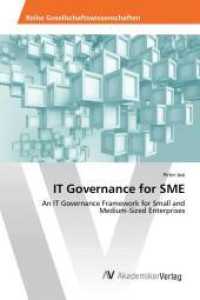Full Description
Across the United States, schools face the daunting issue of confronting the widespread effects of bullying, which threaten the physical, emotional, and intellectual well-being and development of youth. Creating and Negotiating Collaborative Spaces for Socially-Just Anti-Bullying Interventions for K-12 Schools is a theoretically and empirically grounded edited volume that describes practical ways to address bullying at both systemic and individual levels. Central to the scope of the book is a diversity-focused approach to assessing and conceptualizing discrimination and bullying among marginalized youth, such as LGBTQ, mixed race, gifted and talented, and special needs populations.
Interspersed with concrete, real-life examples, each chapter in the volume expands on the multiple dimensions of bullying as well as research-backed anti-bullying interventions. The book advances previous literature by addressing contemporary issues in bullying. Special topics include teacher-to-student bullying, cyberbullying, restorative justice practices, and assessment of attitudes toward addressing bullying.
Contents
Preface: Building Anti-Bullying and Socially Just School Spaces: Educational Context, Dynamics, and Research Considerations; Melinda Lemke.
Section I. New Visions for Addressing Bullying in Schools.
Chapter 1. What Is Bullying? Using Social Norming and Ecological Theories to Better Understand the Pandemic; Azadeh F. Osanloo and Jonathan P. Schwartz.
Chapter 2. Holistic Systemic Approaches to Promoting Anti-Bullying; Christa Boske.
Chapter 3. Training School-Based Practitioners to Prevent and Address Bullying, Discrimination, and Harassment in Schools: A Preservice Model; Gretchen Brion-Meisels and Bernice R. Garnett.
Chapter 4. Facilitating Cognitive and Social-Emotional Growth: Empathy and Prosocial Behavior; Alison Black.
Chapter 5. Assessing Attitudes Towards Addressing Bullying: A Diversity Centered Approach; Jonathan P. Schwartz and Azadeh F. Osanloo.
Chapter 6. Bullying As a Function of Parenting and Attachment Styles; Nessa Villalobos and Maria D. Avalos.
Section II. Bullying, the Spectrum of Difference, and Otherness.
Chapter 7. Early Adolescent Bullying, Human Differences, and the Gifted and Talented; William Thomas Allen, Jr.
Chapter 8. Creating Spaces for Critical Conversations about Bullying through Focused Studies; Peggy S. Rice.
Chapter 9. The Effects of Bullying Among Adolescents With Special Needs; Irasema Ramirez.
Chapter 10. Challenging LGBTQ Bullying Through a Teacher Discussion Group; Stephanie Anne Shelton.
Chapter 11. Ethnic Minority Youth and Bullying; Sally M. Hage, Ronald Ma, and Yunjin Lee.
Chapter 12. Mixed-Race Student Awareness in K-12: Bullying and Discrimination Among Mixed-Race Student Populations; René O. Guillaume and Charlotte Williams.
Section III. Teachers, Schools, and the (New) Problems of Bullying.
Chapter 13. Teachers As Activists: Using a Black Feminist Pedagogy to Prevent Classroom Bullying; Shemariah J. Arki.
Chapter 14. Problematizing Teacher Authority to Uncover and Address the Reality of Teacher Bullies; Tanji Reed Marshall.
Chapter 15. How Schools Unintentionally Support Bullying and What Can Be Done to Stop It; Ann Kaczkowski Kimpton and Paul Kimpton.
Chapter 16. Cyberbullying: A New Twist on a Familiar Problem; María D. Avalos, Janet A. Carter, and Justus C. Onyenegecha.
Section IV. Innovative Interventions and Approaches.
Chapter 17. The Promise of Restorative Practices as Interventions for Bullying in K-12 Schools; Christopher C.W. Johnson and Vicki Oberstar.
Chapter 18. Positive Behavior Interventions and Supports: A Promising Approach to Reducing Bullying in Schools; Seth A. King, Krystal Kennedy, and Helen Dainty.
Chapter 19. From Book Group to Bullying Prevention: The Story of the Social Justice Reading Group; Kate Muir Welsh and Kate Kniss.
Chapter 20. Using Children's Multicultural Picture Books to Combat Bullying; Kathy Brashears and Queen Ogbomo.
Chapter 21. Restoring Relationships: How Restorative Justice Can Be a Multitiered Antibullying Intervention; Olivia Marcucci.
Chapter 22. Closing Thoughts; Cynthia Reed.
About the Contributors.








